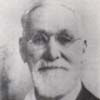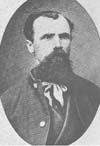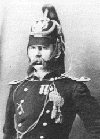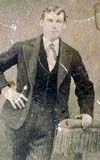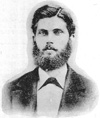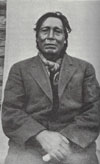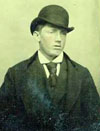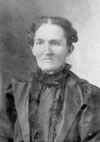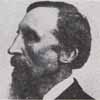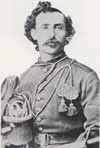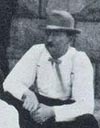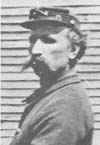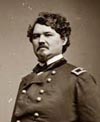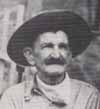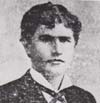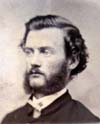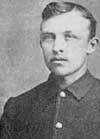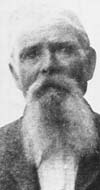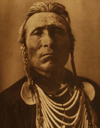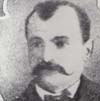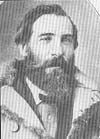Merry Christmas!
Timothy Haley was born in County Cork, Ireland, on December 25, 1846. He was born on Christmas, and he died on New Year’s Eve (see last entry). He was a Private in Company H who participated in the hilltop fight during the Battle of the Little Bighorn.
Edwin Butler Wight was born in Casco, Maine, on December 25, 1849. He was a Private in Company B who was on detached service at Powder River, Montana, during the battle.
Thomas W. Coleman was born on December 25, 1850, in Troy, New York. He was a Private in Company B who with the pack train and in the hilltop fight.
Michael Christopher Caddle (left) was married on December 25, 1877, to Josephine Lee McIlhargey (right) the widow of Private Archibald McIlhargey who was killed during the battle.
William Millard Caldwell (right) married Blanche Miller on December 25, 1887, in Clearfield, Pennsylvania. He was a Private in Company B who was on detached service at Powder River, Montana, during the battle.
John Sivertsen (left) married Anna Olson on December 25, 1889, in Douglas County, Wisconsin. He was a Private in Company M who participated in the valley and hilltop fights.
Thomas Wilford Harrison (left) died on December 25, 1917, in Philadelphia, Pennsylvania, and was buried in Holy Cross Cemetery in Yeadon, Pennsylvania. He was a Sergeant for Company D who was in the hilltop fight.
Stephen Cowley (right) was born on December 26, 1846, in Sligo, Ireland. He was a Private in Company D who was not present at the Battle of the Little Bighorn due to detached service at Powder River, Montana, guarding the wagon train.
Max Hoehn (left) was born in Berlin, Germany, on December 26, 1854. He was a Private in Company L who stayed with the regimental papers at Powder River so he was not in the battle.
John Meyers died of consumption on December 26, 1877, at Fort Abraham Lincoln in the Dakota Territory and was buried in the Custer National Cemetery in Montana. He was the Saddler for Company C who participated in the hilltop fight. He was later wounded in 1877 during Gen. Miles’ fight with Chief Joseph.
John J. Fay and John Fox both died in Washington, D.C., on December 26, 1932. Fay and Fox both were buried in the Soldiers’ Home National Cemetery there. Both were Privates in Company D. Fay participated in the valley and hilltop fights, and Fox was in the hilltop fight.
Frank Hunter died on December 27, 1899, in Washington, D.C., and was buried in the Soldiers’ Home National Cemetery there. He was a Private in Company F who was with the pack train and in the hilltop fight during the battle.
Wilson McConnell died on December 27, 1906, in King, Wisconsin, and was buried in the Wisconsin Veterans Memorial Cemetery there. He was a Private in Company K who participated in the hilltop fight during the battle.
Peter Thompson (left) was born in Markinch, County Fife, Scotland, on December 28, 1843. He was Private in Company C who was wounded in the hilltop fight. He was awarded the Medal of Honor for his actions during the battle.
Three of the men who served with the Seventh Cavalry in 1876 were killed during the Battle of Wounded Knee in South Dakota on December 29, 1890:
Richard Winick Corwine was a Private in Company A on detached service at Fort Abraham Lincoln during the battle. He was killed at Wounded Knee and buried in the Pine Ridge Cemetery, but he was reinterred in the Fort Riley Post Cemetery in September 1906.
Gustave Korn (left) was a Private in Company I and participated in the hilltop fight. He became the caretaker of Comanche, the only horse that survived the battle. He was killed at Wounded Knee and buried in Pine Ridge Cemetery, but he was reinterred in the Fort Riley Post Cemetery on December 17, 1892.
George Daniel Wallace (right) was a Second Lieutenant who commanded Company G during the battle and fought in the valley and hilltop fights. He died at Wounded Knee of bullet wounds to his head and abdomen and was buried on January 6, 1891, in Rose Hill Cemetery in Yorkville, South Carolina.
Crawford Selby (left) and Mary Elizabeth Beck divorced on December 30, 1874, after ten years of marriage. He was a Saddler with Company G who was killed during the retreat from the valley fight.
William Jackson (right) died at Cutbank Creek on the Blackfeet Reservation in Montana on December 30, 1899, and was buried in St. Michael’s Cemetery in Browning, Montana. He was a scout who participated in the valley fight.
David W. Lewis died on December 30, 1914, at the Government Hospital for the Insane in Washington, D.C., and was buried in Arlington National Cemetery at Section 17, Site 18504. He was a Private in Company B who was confined at Fort Barrancas, Florida, at the time of the battle.
William Henry Miller died in San Antonio, Texas, on December 30, 1914, and was buried in the National Cemetery there. He was the Blacksmith for Company E who was with the pack train and in the hilltop fight.
William R. Oman was born on December 31, 1843, in Hamilton County, Indiana. He was a Private in Company D who participated in the hilltop fight.
Timothy Haley died on December 31, 1913, in Washington, D.C., and was buried in the Soldiers’ Home National Cemetery there. He was a Private in Company H who participated in the hilltop fight.
